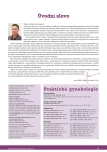-
Medical journals
- Career
Perioperative adhesion prevention in gynaecology.
Authors: S. Pánková; R. Hudeček; E. Račanská
Authors‘ workplace: Gynekologicko-porodnická klinika LF MU a FN Brno
Published in: Prakt Gyn 2009; 13(2): 70-75
Overview
The aim of the study:
An analysis of experiences with application of 100% hyaluronic acid for perioperative adhesion prevention during laparotomy and laparoscopic surgeries in reproductive gynaecology.Material:
The study involved a sample of 39 female patients who underwent surgery between 1.2.2009 and 30.3.2009 at the Clinic of gynaecology and obstetrics, Masaryk University and Teaching Hospital in Brno, and who were administered 100% hyaluronic acid gel to the area of the lesser pelvis. There were 15 (38.5%) laparotomies and 24 (61.5%) laparoscopic surgeries. The surgery was indicated for uterine myomatosis in 13 patients (33.3%), for ovarian cysts in 13 patients (33.3%) and for lesser pelvis adhesions in 7 patients (17.9%). Six patients (15.4%) had another indication for surgery.Methods:
A total of 10 ml of hyaluronic acid was applied at the end of surgery when the planned procedure was completed and after the bleeding at the surgery site was carefully stopped. The integrity of the gel was preserved in order to ensure that the applied layer of the gel covers the area of the operated focus and that it reaches and covers the surrounding healthy tissue. Following laparotomy surgeries, the gel was applied using thick blunt needle, after laparoscopic surgeries the gel was applied through laparoscopy port using an original application kit.Results:
In the laparotomy surgery group, hyaluronic acid gel was applied following myomectomy (13 patients, 33.3%), endometrioma cystectomy in one patient (2.6%) and after adnexectomy for chronic post‑inflammatory adnexal tumour in one patient (2.6%). Ovarian cyst cystectomy was the main indication for hyaluronic acid application in the laparoscopy surgery patients; of the total of 12 surgeries (30.8%), 10 were for endometrioma (25.6%) and 2 surgeries (5.1%) were to remove dermoid cysts. The gel was applied after laparoscopic adhesiolysis of the lesser pelvis in 7 patients (17.9%), after laparoscopic salpingectomy in 3 patients (7.7%), after unilateral tubal neostomy in one patient (2.6%) and after unilateral adnexectomy in one patient (2.6%).Discussion:
Clinical efficacy and safety of hyaluronic acid application was confirmed in a multicentre study presented at the World Congress of Gynecologic Endoscopy in Bari in 2008. The study involved 389 patients from 11 Italian centres after endoscopy surgery compared to control group without an anti‑adhesion prevention. The study showed significantly lower incidence of adhesions when hyaluronic acid was used compared to control group and no difference in the incidence of adverse events between the groups. Indications for the use of anti‑adhesion gel include the broad spectrum of pathologies of the lesser pelvis.Conclusion:
100% hyaluronic acid gel represents a highly effective perioperative adhesion prevention in reproductive gynaecology. Application of the laparotomy and laparoscopic forms of the gel is easy and does not require special instruments. A multicentre study showed significantly lower incidence of post‑operative adhesions after the application of 100% hyaluronic acid and no difference in the incidence of adverse events compared to the control group.Key words:
adhesions – hyaluronic acid – perioperative adhesion prevention – barriers
Sources
1. Weinberger V, Crha I. Hojení peritonea, tvorba adhezí a možnosti jejich prevence. Prakt Gyn 2005; 9(1):10–12.
2. Metwally M et al. Hyaluronic acid for adhesion prevention. Gynec Surg 2007; 87(5).
3. Mais V et al. Hyalobarrier for preventing postoperative adhesions: Systematic review and meta‑analysis of safety results in randomized controlled trials. Italy, Bari: Světový endoskopický kongres 2008.
4. Darmas B. Use of barrier products in the prevention of adhesion formation following surgery. Journal of Woud care 2008; 17(9): 405–408.
5. DiZerega GS, Tulandi T. Prevention of intraabdominal adhesions in gynaecological surgery. Reprod Biomedicine Online 2008; 17(3): 303–306.
6. Baakdah H, Tulandi T. Adhesion in gynecology complication, cost and prevention: a review. Surg technology International 2005; 14 : 185–190.
7. Aytekin FO et al. Role of hyaluronic acid derivate in preventing surgical adhesions and abscesses related to dropped bile and gallstones in experimental model. Americ Journal of Surgery 2004; 188(3): 288–293.
8. Pellicano M, Bramante S et al. Effectiveness of autocrosslinked hyaluronic acid gel after laparoscopic myomectomy in infertile patients: a prospective, randomized, controlled study. Fertility and sterility 2003; 80(2): 441–444.
9. Reijnen M et al. Pathophysiology of intraabdominal adhesion and abscess formation, and the effect of hyaluronan. British Journal of Surgery 2003; 90(5): 533–541.
10. Besim H et al. Prevention of intraabdominal adhesions produced by polypropylene mesh. European Surgical Research 2002; 34(3): 239–243.
11. Račanská E, Petrenko M, Ventruba P et al. Digitální obrazový archív. Prakt Gyn 2007; 4 : 179–183.
Labels
Paediatric gynaecology Gynaecology and obstetrics Reproduction medicine
Article was published inPractical Gynecology

2009 Issue 2-
All articles in this issue
- Perioperative adhesion prevention in gynaecology.
- Adenocarcinoma in situ of the uterine cervix – analysis of 10 cases
- Thyroid cancer therapy with radioiodine 131I, the impact on gonadal functions and fertility.
- Some bioethical questions in assisted reproduction – review of literature (Strassbourg convention, human embryo status).
- Pregnancy loss after the assisted reproductive technologies.
- Intrahepatic cholestasis of pregnancy and treatment with ursodeoxycholic acid.
- Identification of the estrogen alpha receptor in normal endometrium and in clear cell carcinoma
- Forensic Aspects of Assisted Reproduction in Czech and Slovak Legislation
- Practical Gynecology
- Journal archive
- Current issue
- Online only
- About the journal
Most read in this issue- Intrahepatic cholestasis of pregnancy and treatment with ursodeoxycholic acid.
- Pregnancy loss after the assisted reproductive technologies.
- Thyroid cancer therapy with radioiodine 131I, the impact on gonadal functions and fertility.
- Perioperative adhesion prevention in gynaecology.
Login#ADS_BOTTOM_SCRIPTS#Forgotten passwordEnter the email address that you registered with. We will send you instructions on how to set a new password.
- Career

